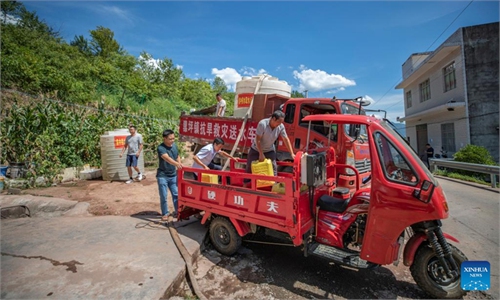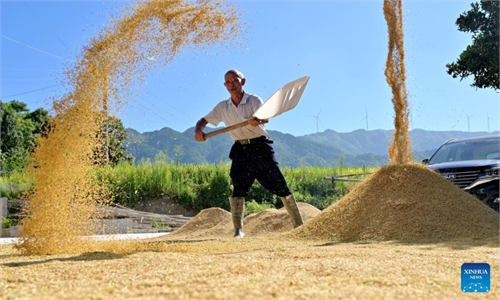Rivers in multiple provinces dry up due to high temperatures, less rain
South-to-North water diversion project unlikely to be affected: expert

A large area of a beach along the Yangtze River is seen from above in Wuhan, Central China's Hubei Province on August 15, 2022. On that day, the water level in many parts of the Yangtze River was the lowest for the period since hydrological records began in 1865. Photo: VCG
Rivers in multiple provinces and regions across China have dried up due to persistent high temperatures and far below average amounts of rainfall, resulting in drought in many parts of the nation. Data from China's Water Resources Ministry shows that the water supply of 830,000 people in six provinces and regions has been affected.
Long-lasting heat waves have hit multiple areas with East China's Anhui, Central China's Hunan, and Southwest China's Guizhou and Chongqing Municipality reporting that rivers have dried up, so that towns and villages along the rivers have to endeavor to build dams to secure farmland irrigation and drinking water.
In Anhui, one of China's most important grain production provinces, several places including Huaining county in Anqing, Qingyang county in Chizhou and Tongcheng city have seen multiple main rivers dry up due to persistent heat waves. In Huaining and Anqing, eight towns and villages along several main rivers that have dried up are suffering from shortages of agricultural irrigation and water for daily usage.
"The rice in the fields is all dry now," a villager in Qingyang county, Anhui, told the Global Times on Monday. "However, the villagers have running water in their homes and water for life is not affected."
An official from Qingyang county told the Global Times that this year's grain harvest will definitely be affected because of the lack of water. But the local authorities have taken measures such as lifting water for irrigation and drilling new wells.
An official from Huanglong town in Anhui's Huaining county told the Global Times on Monday that the situation of drought was "serious." However, local residents' domestic water and drinking water supplies have not been affected for the time being, he said.
"We have made good deployments, with reservoirs upstream releasing water, and many electromechanical wells have been drilled in the fields for irrigation," the official said.
Statistics from the water bureau in Anqing show that the water level of the Yangtze River in Anqing was 8.41 meters on August 11, or 5.36 meters lower than usual, leading to the drought of the tributary rivers of the Yangtze River in Anhui.
The flood and drought control authority in Qingyang county, Chizhou issued a notification on August 10 saying that cumulative precipitation in the county was only 1.7 millimeters, 97 percent less than that of the same period in previous years, (52.2 millimeters) since August 1, according to The Paper.
The local authority revealed that more than 70,000 mu of rice production had been affected by the drought, and a few towns and villages had used back-up water sources to relieve people's temporary drinking water difficulties.
The Ministry of Agriculture and Rural Affairs has sent 25 work groups and 12 technology teams to the region to direct the fight against drought and secure the harvest in autumn in the hardest-hit areas and the key grain production regions, according to the Xinhua News Agency.
Meanwhile, in Chongqing, seven rivers and one reservoir have dried up and the 476 tube wells generated insufficient water as of 8 am on Friday, which led to 276,000 people and 82,400 farm animals suffering from shortages of drinking water.
Besides, the scenic spot Dongting Lake in Hunan entered the dry season four months earlier than usual and the great waterfalls at the Chishui Danxia tourist attraction in Zunyi city, Guizhou have also suffered from drought.
The recent massive drought in the flood season in southern China is historically rare, Ma Jun, director of the Beijing-based Institute of Public and Environmental Affairs, told the Global Times on Monday, noting that the main cause was unusual weather.
"In June and July, the entire Yangtze River basin was controlled by a subtropical high pressure system due to La Niña events. The characteristic of this pressure system is that it makes the air very dry and creates sinking air currents, leaving the region in a state of prolonged sunny heat and little rain," Ma said. "During what would have been the rainy season but with little to no rainfall, the entire region is in a state of drought."
While no major cities are reporting water use difficulties, there have been some small towns and villages where water supplies have been affected. Ma noted that in addition to water supply, there is an impact on the security of electricity supply, which is something that requires additional attention, due to rising demand for electricity and declining hydropower generation capacity.
While some rivers in southern China have seen water levels drop, the world's largest inter-basin water transfer project - the South-to-North water diversion - is not expected to be affected, Ma said.
"The water being withdrawn in the South-to-North water diversion is mainly from the mainstreams of the major rivers. At the moment, no river mainstreams have reported significant water shortages," he said. "For example, the water that Beijing gets through the project comes mainly from the Hanjiang River. And the water level of the Hanjiang River's mainstream is still at a safe level."
In addition, northern cities are currently at a stage where there is no shortage of water, as there has been significantly more precipitation in the north this summer than in previous years. For example, the water level in the Miyun Reservoir, the largest reservoir in Beijing, has reached a high level, Ma said.
China's South-to-North Water Diversion Project, the largest of its kind ever undertaken, involves drawing water from southern rivers and supplying it to the dry north. The east and middle route of the project has transferred over 50 billion cubic meters of water from major rivers in the south to the drought-prone north since entering operation about seven years ago, gmw.cn cited sources from the Ministry of Water Resources as saying in May.
Some 140 million people have been benefited and economic development pattern of more than 40 large and medium-sized cities were optimized thanks to the project, the company in charge of the project revealed last December.
However, Ma also warned that while this year's drought in southern China is historically a rare event, caused mainly by weather extremes, there is a risk that such conditions will become more frequent.
"The general consensus among climatologists is that extreme heat will become more frequent in the future," he said. "China's Yangtze River basin, which is already at the latitude of the planet's arid regions, is relatively wet because of monsoonal influences. If the monsoon or ocean currents continue to change, this region could be affected even more."


